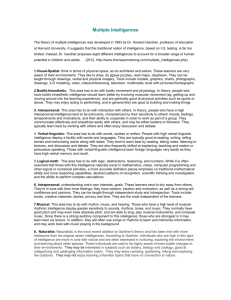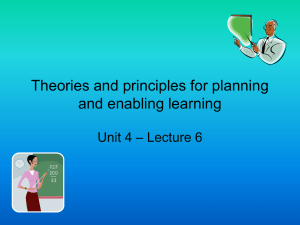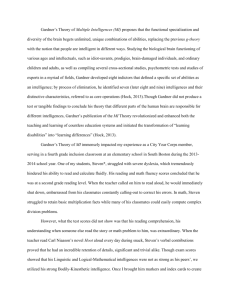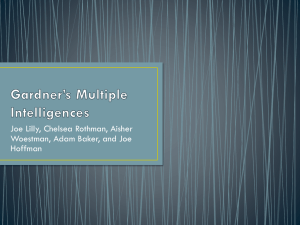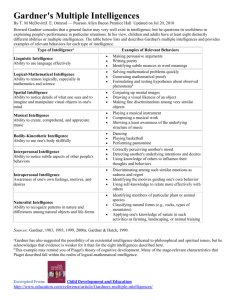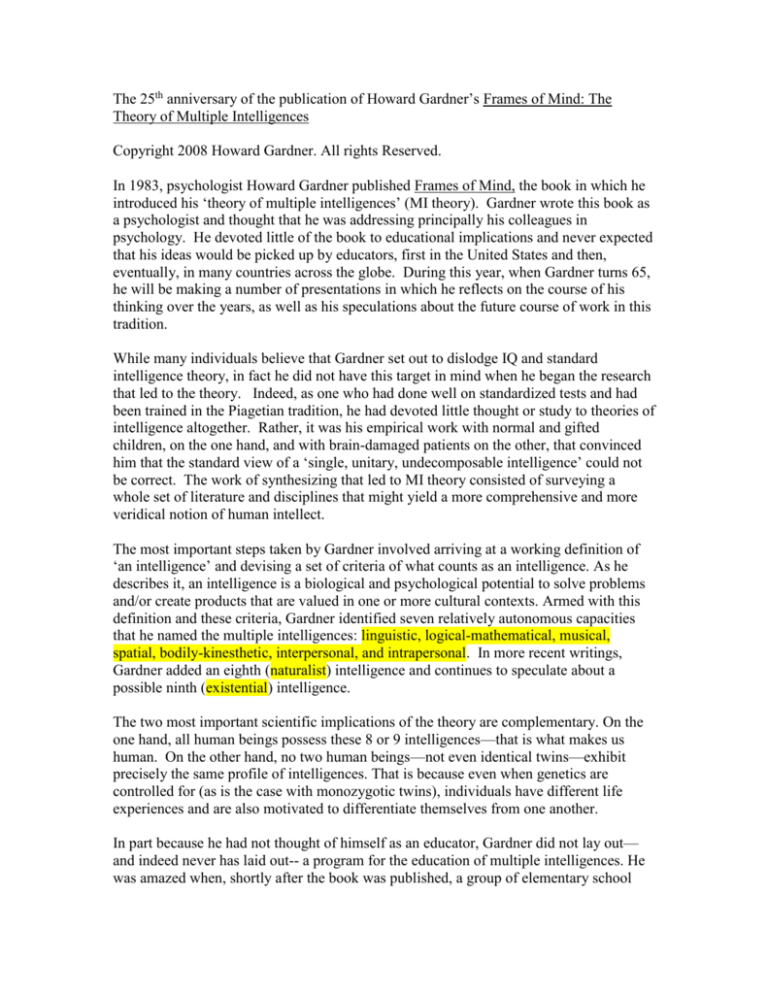
The 25th anniversary of the publication of Howard Gardner’s Frames of Mind: The
Theory of Multiple Intelligences
Copyright 2008 Howard Gardner. All rights Reserved.
In 1983, psychologist Howard Gardner published Frames of Mind, the book in which he
introduced his ‘theory of multiple intelligences’ (MI theory). Gardner wrote this book as
a psychologist and thought that he was addressing principally his colleagues in
psychology. He devoted little of the book to educational implications and never expected
that his ideas would be picked up by educators, first in the United States and then,
eventually, in many countries across the globe. During this year, when Gardner turns 65,
he will be making a number of presentations in which he reflects on the course of his
thinking over the years, as well as his speculations about the future course of work in this
tradition.
While many individuals believe that Gardner set out to dislodge IQ and standard
intelligence theory, in fact he did not have this target in mind when he began the research
that led to the theory. Indeed, as one who had done well on standardized tests and had
been trained in the Piagetian tradition, he had devoted little thought or study to theories of
intelligence altogether. Rather, it was his empirical work with normal and gifted
children, on the one hand, and with brain-damaged patients on the other, that convinced
him that the standard view of a ‘single, unitary, undecomposable intelligence’ could not
be correct. The work of synthesizing that led to MI theory consisted of surveying a
whole set of literature and disciplines that might yield a more comprehensive and more
veridical notion of human intellect.
The most important steps taken by Gardner involved arriving at a working definition of
‘an intelligence’ and devising a set of criteria of what counts as an intelligence. As he
describes it, an intelligence is a biological and psychological potential to solve problems
and/or create products that are valued in one or more cultural contexts. Armed with this
definition and these criteria, Gardner identified seven relatively autonomous capacities
that he named the multiple intelligences: linguistic, logical-mathematical, musical,
spatial, bodily-kinesthetic, interpersonal, and intrapersonal. In more recent writings,
Gardner added an eighth (naturalist) intelligence and continues to speculate about a
possible ninth (existential) intelligence.
The two most important scientific implications of the theory are complementary. On the
one hand, all human beings possess these 8 or 9 intelligences—that is what makes us
human. On the other hand, no two human beings—not even identical twins—exhibit
precisely the same profile of intelligences. That is because even when genetics are
controlled for (as is the case with monozygotic twins), individuals have different life
experiences and are also motivated to differentiate themselves from one another.
In part because he had not thought of himself as an educator, Gardner did not lay out—
and indeed never has laid out-- a program for the education of multiple intelligences. He
was amazed when, shortly after the book was published, a group of elementary school
teachers from Indianapolis approached him and said that they wanted to start an “MI
School.” For over twenty years, Gardner has been an informal adviser to the Key
Learning Community; but he has always stressed that the teachers are the educators, the
school people, and his views should be take as advisory only. He has assumed the same
low-key stance toward the many other educators around the world who have approached
him with requests for help in setting up an “MI school.”
For the same reason, Gardner kept silent for a decade when individuals approached him
for comments on various implementations of his ideas. Only when he saw his ideas
radically abused, as happened in Australia in the early 1990s, did he intervene. (Gardner
objected strenuously to a statewide educational intervention that described major racial
and ethnic groups in Australia in terms of the intelligences that they purportedly had and
the ones that they purportedly lacked).
Spurred by this “wake up call”, Gardner did write about the various myths and
misunderstanding of MI theory—for example, confusing an intelligence with a learning
style, or asserting that all children are strong in at least one intelligence. Moreover, he
now believes that any serious application of MI ideas should entail at least two
components;
l. An attempt to individuate education as much as possible. The advent of personal
computers should make this goal much easier to attain.
2. A commitment to convey important ideas and concepts in a number of different
formats. This activation of multiple intelligences holds promise of reaching many more
students and also demonstrating what it means to understand a topic thoroughly and
deeply.
Looking toward the future, Gardner expects MI theory and practice to expand in a
number of directions:
l. Application of these ideas in institutions other than schools—for example, museums,
government, the workplace;
2. Devising of computer software and virtual realities that present or teach the same
topics via the activation of several intelligences;
3. Exploration of the genetic bases for the various intelligences. When Gardner began his
work, almost nothing was known about the genetics of various abilities. This situation
should change dramatically in coming years.
4. Refinement of our understanding of the neural bases of intelligences and the ways that
they develop and interact. Gardner’s original theory was based in significant part on the
knowledge of brain specialization available around 1980. There has been an explosion
of knowledge about neural networks and connections since this time, as well as the
emergence of many new techniques for assessing brain structure and functioning in vivo.
This knowledge can and will lead to a superior delineation of human capacities, and, in
all probability, to a more authoritative statement of the boundaries between and across
different human intelligences.
5. Study of how MI theory has been implemented around the world. While MI ideas
have been picked up in a broad range of developed and developing societies, the ways in
which these ideas have been used, and the obstacles that they have encountered, differ
dramatically and at times in unexpected ways. To document this trend, Gardner and
colleagues Jie-Qi Chen and Seana Moran, are editing a book that contains over two dozen
essays by theorists and practitioners from a wide gamut of countries and institutions.
Among the most striking is the Explorama at Danfoss Universe in Denmark, an entire
theme park based on MI theory. Many of the authors gathered at the March 2008 meeting
of the American Educational Research Association; it is expected that the edited book, to
be published by Jossey-Bass, will appear in 2009.
In addition to the question of how MI theory has been understood and fashioned in
different soils, the book will also address the more general issue of how ‘educational
memes’ travel.
6. Synthesis of MI theory with other work currently being undertaken by Gardner and
colleagues. Over the last dozen years, Gardner and a team of researchers have been
studying ‘good work’ (goodworkproject.org). This work focuses on the benevolent uses
to which human intelligence, creativity, and leadership can be (but are not necessarily)
applied. More recently, Gardner’s research group has also begun to examine how the
current generation of young people is being affected by the new digital media—another
area ripe for investigation in terms of MI theory. Finally, Gardner has ventured into the
policy arena, as in his recent book Five Minds for the Future. Gardner is pondering the
relationships – as well as the tensions—between how human beings are understood by
scientific study (as in MI theory) and how they should be nurtured by educational
institutions.
April 2008



